Flying into Phnom Penh (pronounced Nom Pen) I could have sworn I was arriving back home – the land was the same familiar dry brown, there were fences, dams and cows. The trees however were slightly different – tall palms instead of gums.
Myself and two other volunteers – Phillipa and Cam (Kiwis living in Perth) arrived together at the airport and we were taken into the city via tuk tuk. I wasn’t expecting that at all, I had just expected a car or mini van…but somehow we all managed to to jam our backpacks and ourselves into the wooden cart and off we went!
At the accommodation for the night, in the city, I also met two other people who were heading out to the Elephant Project; Ikran and Sarah from Canada. We all enjoyed a few Cambodia beers ($1 each!) and got to know each other.
The next morning bright and early the five of us enjoyed breakfast before jumping into a mini van (thank goodness – I couldn’t have done a tuk tuk for five hours!) and off we went with our driver who spoke not a single word of English.
We darted and dived through the streets of Phnom Penh – as you would expect – there are no formal road rules other then never, ever look back and fend for yourself at all times. When a driver comes to an intersection they just make their own way around other cars, motor bikes and tuk tuks and all the other drivers make their way around too and somehow everyone manages to get where they want…
We were in Phnom Penh for an hour at least – we stopped to pick up a elderly lady – who again spoke no English. She had long, red, fake fingernails and an outfit of tracksuit pants, a silk shirt and socks and wedge shoes. Her hair and make up was immaculate. She talked the whole way…either to the driver or on her mobile phone. I had absolutely no idea what she was talking about but I could just imagine her gossiping about her neighbours or daughter in law! We also picked up another fellow – again nudda English! I have absolutely no idea who he was. The driver stopped at a bakery and purchased bread and cakes and at a service station to buy drinks and chips. Us volunteers are just looking at each other thinking “what the hell!?”. Little did we know the journey was only beginning.
Finally at 8am we hit the outskirts of Phnom Penh and thats when I realised this was gonna be a loooong trip. I’m not usually a panicky person, I don’t stress much but seriously oh my god – Cambodians are the craziest drivers ever and the roads are just destroyed.
So a few highlights of the trip:
– the four lane “highway” just outside of Phnom Pehn turns into a dirt road for about 50 kilometres; so you choke on dust and hang on for dear life when the van hits a pot hole.
– the radiator in the van decided to “crap” itself after an hour or so – we pull into a servo and about five men yelled at each other in Khmer about how to fix it – finally the radiator gets filled up with water and coolant and off we go again.
– I learnt that madly honking your horn at every motorcycle we pass is totally normal and not done in rage – its polite, so the person knows a much bigger vehicle is coming.
– overtaking in Cambodia is skill and its common practice to overtake around a corner or over a hill; you just assume the other driver will slow down or three cars will fit across the road. I don’t know how many times everyone in the bus held their breath as we watched cars coming along to us in the wrong lane.
– slowing down through villages is a no no – the driver just needs to honk his horn to let by-standers know “don’t step out onto the road or its all over buddy”.
– dogs, chickens and pigs are extremely road savvy – they have to be or they will get cleaned up – no one will stop for them, but they always seem to run out of the way just in time! One of the girls already at the sanctuary said she witnessed a cow being hit by a bus coming in the opposite direction – she said it was the most distressing thing she had ever seen as the bus could have clearly slowed down and the driver did not stop. Her driver told her that no-one ever stops if they hit an animal as that cow was/is someone’s livelihood and having to pay for killing the cow would be extremely expense – it would also be the driver’s fault not the farmer’s fault.
– we came around a bend (way too fast) and everyone went flying off their seats into the right hand side of the van (no seat belts) – we stopped again on the side of the road to discover the van had blown a tyre.
– luckily there is always a village within a couple of kilometres of each other – so we limped into town and found a small wooden shop and watched a young boy (all of 15 or 16) spend at least an hour repairing the tyre.
– a definite highlight of the trip was when we were waiting for the tyre to be fixed a couple of young children wandered over to very shyly look at us crazy Westerners. They were absolutely beautiful kids, they hid behind each other and smiled and waved back at us. In the stinking heat, some of them were dressed in jackets and pants. Sadly they were extremely dirty and their teeth were already rotting. But surprisingly they did now some English. I remembered I had bought some pens with Australian animals and pictures on them, so I digged them out from my bag and gave the three children a pen each. Their smiles were incredible – they were so excited and bowed their heads to me and put their hands together in thanks. I then got my notebook and pulled some paper out for each child and we had an instant classroom! Phillipa draw pictures and the kids had a great time copying what she drew. Slowly we had more children come and see what was happening; each child got a pen and some paper. I think we ended up with at least ten kids all drawing pictures of trees, dogs, flowers, houses, motorbikes and then we started saying words like “hello”, thank you” and “good-bye” to each other. They must all attend school and learn English as they all could write reasonably well. When the tyre was fixed and we had to leave the children all skipped off with their pens and paper and waved goodbye to us. It was a fantastic moment.
– the air con in the van decided to die, so it was windows open the last hour or so of the trip.
Finally after seven (not the expected five) extremely long, bumpy, hot and scary hours we arrived in a small town called Sen Monorom. What blew me away was that in kilometres from Phnom Penh it is only about 350kms.
From here I met Gemma who is second in charge at the Elephant Sanctuary. What I learnt was that Globalteer don’t actually run the sanctuary, they are just a facilitator. The sanctuary is actually called “Elephant Valley Project” and it was started by an Englishmen – Jack Highwood – back in around 2005 when he was only 21 years old.
You can view the website by clicking here http://www.elephantvalleyproject.org
Jack wasn’t around during the time I was at the sanctuary – he was doing research in Thailand – however Gemma who is next down the line and has been working at the sanctuary for three and a half years was in charge. Gemma is an Aussie and I don’t know how she lives in such a remote part of Cambodia and supervises the four Western staff and numerous Mahouts, cleaners and cooks, plans the weekly tasks to be done for the volunteers, organises the day visitor bookings and their excursions, does most of the administrative work for the sanctuary, works with the local community to organise any elephants that need to come to the sanctuary, works on conservation and environmental issues within the protected land – including tree logging, deals with poachers and basically any issues that arises – Gemma handles it. She also speaks Khmer. Wow!
The Project is about 30 minutes drive from town and usually volunteers stay on site, however the Project is currently having some “licensing issues” and difficulties with some tour operators in town. Therefore us volunteers were placed into some accommodation about 15 minutes from the Project.
The accommodation was basic. The most basic I have ever stayed in. It was certainly an experience. It was basically a log cabin/shed (with gaps everywhere between the timber) with a concrete floor, tin roof and about half a metre off the ground slates where the mattresses lay. There were also mozzie nets to keep the mozzies, cockroaches, bugs, termites, spiders and flys away. There was no ceilings fans and most definitely no air conditioning. The bathrooms were down the end. They were concrete floors with a Western style toilet – however it didn’t flush – you had to use a bucket of water to wash it through, and a shower head with cold water only. Even though it was extremely basic and hot, it was clean, the sheets and bedding were clean and after a night it was actually pretty comfortable.
There was a dining room near the “shed-room” where dinner was served and the kitchen was located. Above the dining room was an amazing platform with beautiful views over the jungle- I got some great sunset photos from here. There was also about 4 cabins that were similar in style to the shed-room just for couples staying together.
Roger the dog and one of her pups – Brindle (yeah I didn’t bother asking about how Roger ended up getting her name) lived on site, along with a rooster and some chooks. I also saw a black cat sneaking around from time to time. Helen, who is the volunteer coordinator, also lives on site in one of the cabins and basically is someone there to look after us. Helen is from the UK and is currently doing a three month stint after doing some work at the Project last year. Kenzie was another volunteer who was staying for six weeks. She is from the USA and only 20 years old – I thought she was so brave!
Breakfast and dinner were served in the dining room and both were prepared by a restaurant in town and brought out by scooter at 7am and 6.30pm daily. Breakfast was crepes with local honey and fruit. Dinner was rice with usually a veggie dish and a chicken dish or some noodles. They were both really delicious. Everyone took turns then to do the dishes in the small kitchen out the back. There was no sink, so we had to rinse the dishes by bucket into a drain on the concrete floor and then wash them in a stainless steel tub. Surprisingly I never got sick once. There was also no fridge so cans of beer and coke were kept in a large esky with ice. The water was provided in 10 litre tanks, but was never cold, just room temperature.
A typical day started by waking up at around 6.30am and getting ready, packing my backpack, filling up my water bottles, putting sunscreen on and having breakfast. We usually piled into the van or the “truck” by 7.40am. The van was luxury – normal seats and air con. The truck is a beaten up old Toyota Hilux duel cab with seats in the tray. It was very dusty if you were the unlucky one in the back but good fun!! Helen would drive us to the Project and we would arrive by 8am.
Most days on our drive to the Project we stopped to pick up Terra. Terra is a Bunong – which is a native or aboriginal Cambodian. The Bunong people are “animists” meaning that they believe things such as animals, plants, rivers and mountains possess a spiritual being or a soul if you like. They are only found in the Mondulkiri provence. Terra works as a cleaner at the Project, where many local Bunong people are employed as Mahouts, cooks, caretakers, security guards, park rangers and cleaners. True to the Cambodian people Terra is extremely shy and weary of new people but once she does feel comfortable you can usually get a smile out of her. Terra did not speak any English at all.
Sadly Terra has recently had a rough trot – her small timber hut/house caught fire and burnt down, leaving her and her five children homeless. As she was trying to pay for her house to be re-bulit, this meant she had very little money left over and only enough to feed her children rice once a day, while she ate soil and dirt. Absolutely heartbreaking. Jack organised a working bee and raised some money and helped her built a small shack that at least offers some protection.
On one particular morning Terra and her youngest baby, maybe nine months ago came from their small hut. Terra was wearing the same clothes that she had worn the day before. The small baby had just been washed and while we drove Terra dried the baby and put a pair of pants and a jumper on her. It was very sad to see the clothes were extremely dirty and unwashed but I guess that is all Terra has. As Terra worked at the Project, the little baby was placed in a hammock under the trees near the kitchen and some of the older children watch over her. It really puts life in perspective.
Once we arrive on the hill at the Project, Gemma works out what tasks need to be done by the volunteers and which staff members are allocated to work with us and which staff members are allocated to the day groups. The day groups usually arrive at about 8.30am but they only go to the visit the elephants – they don’t do any work.
During this time us volunteers and the staff members all sit in the red dirt and chat. Its beautiful in the warm sun, looking over the hill towards the jungle and mountain views. I often sat there and thought I can’t believe I’m in such a remote part of Cambodia, of all places. It really is a beautiful place.
One morning as we sat around, Too-en (Too-en is a local who works as a guide) heard an animal noise coming from the jungle and after listening to it, told us it was a gibbon calling. He said it was quite late in the morning for a gibbon to call so we were very lucky to hear it.
On our first day us volunteers got to spend the whole day meeting the elephants. It took us about thirty minutes to trek from the hill down into “Heaven Valley”. Once in the jungle we crossed a river and then waited on a log for the elephants living in this area to be brought in from the jungle for their morning bath.
Seeing the elephants come from out of the jungle for the first time was awesome! In this part of the valley there are five elephants – Ruby, Pearl, Ning Wang, Mae Nang and Onion. It was thrilling watching them amble through – no chains, no leads and no fences between us and them. We were only a few metres away from them. The whole concept of the Project is to just watch and be in the company of the elephants. There is no elephant riding. In our little group we would sit for a couple of hours in the jungle just watching the elephants graze. Only the Mahouts hop on the elephant’s back when they are learning to enter the water. Once the elephants arrived at their watering hole and went in for a bath we were able to walk over closer to them and help throw buckets of water on them.
Some of the elephants know how to bath themselves and spray water on them, others don’t – as they were never able to learn this in their previous life. Hence the Mahouts that help them and scrub and try and show them what to do. Some of the elephants love to get into the water and then drop on one side and just lay there. Others are very cautious and are still learning.
When the elephants are ready to come out from the water, we just moved out of their way and let them do their own thing, they wander where they want. Once Onion comes from the water she likes to throw dirt all over herself!
It was a bit daunting being so close to these elephants, knowing they were wild animals but as the days wore on, I trusted them more and felt comfortable around them.
Once these lovely ladies finish their morning bath they usually head off together back into the jungle to eat and roam and be a happy, normal elephant. Onion always goes her own way however, she doesn’t get along with the rest of the group and has lots of issues to sort out. Onion was used as a logging elephant and worked extremely hard her whole life. One day she stopped working and refused to move anymore. Her owners contacted the Project and asked about her being taken in. This benefits both the Project and the owners. Firstly the owners receive a monthly allowance (less then they would if Onion was still working – but enough for them to live on) and they are able to come and visit Onion whenever they want. For the Project they are able to take Onion in and care for her and know that she is happy and able to enjoy the rest of her life.
The Bunong people still use elephants for labour and they do care greatly for them – they just don’t understand the correct way I guess. It goes back to their beliefs that everything has a soul and an elephant has the greatest soul – ceremonies are held to mark the arrival of a new baby elephant in the village and funerals when an elephant dies. Its mainly the business men from the city who purchase elephants and use them for the tourist trade that are extremely cruel to the elephants.
When Onion first arrived in the Project she be-friended Bob – the only male. Onion and Bob were best friends and did everything together. Onion was acting normal and interacting well and washing herself. Then sadly Bob died late last year – believed to be from old age. I’m sure you have watched on TV or read that elephants take the death of their mates very hard and Onion did/has. She now is back to square one and distanced herself from the others. She now even bites the other elephants on their tails and once pushed Ning Wan down into the river! She definitely has an attitude. But sitting and just watching her you can see a sadness in her eyes….she has had a hard life.
Just before midday we trekked back out of the jungle and down the hill into base camp. This is where the accommodation, kitchen, dining room and sheds are located.
Siesta/lunch time is usually from 11.30am to 2pm and man did I need it! We can lay in hammocks downstairs or go upstairs into the lounge room and lay on chairs and enjoy the amazing view and sometimes catch the breeze. Most of us read, chatted or slept! Lunch is served at 12pm and was always rice, vegetables and fruit. The food was very basic but always delicious.
In the afternoon we trekked into another part of the valley for about an hour or so. This time we got to meet Gee Nowl and Easy Rider; who are besties and are properly the most normal elephants in the Project. They just hang together, eat together and can and will wash themselves very well.
Lastly on the way back to base camp we found Milot in the jungle with her Mahout. If I had to pick my favourite it would be Milot. She is such a gentle giant and really loves people. I don’t know how – as she was used to carry tourists for up to 12 hours a day. Milot is blind in one eye because her handler beat her constantly over this part of her head to make her walk with the large basket full of people. You can see by looking at her that her back is bent out of shape and she has marks where the ropes and chains used to strap the basket over her. Like many of the elephants, Milot is also missing the bottom section of her tail. This was cut off and the hair was used to make jewellery.
You can read all about the elephants and their backgrounds here: http://www.globalteer.org/volunteer-projects.aspx?project=cambodia-elephant-sanctuary#section_11 When you are listening to their stories it is so sad, they really have had a rough life, but its so lovely to see them happy and free now.
At about 4.30pm we usually started the worst part of the day – the dreaded walk back up the hill. I don’t know how one hill can cause so much terror but seriously it was never ending and I’m glad it wasn’t just me. We then pile into the van or truck and back to the camp we go.
The sun is usually setting by the time we get back – about 5.30pm. The sun is massive, a big orange colour tucking itself behind the jungle hills. There were always a few fires burning so there is a smoky haze. When I came back from days of working I was absolutely filthy, smelly, I had blisters on my hands (yeah I’m a sook) and a red dirt everywhere. I liked to sit outside (in more red dirt!) and watch the sunset and play with Brindle. Usually she would have found a stick or bit of rope and she liked to have a game. It was incredibly peaceful and quiet and just being in the middle of nowhere in Cambodia made me feel very happy.
The rest of my time spent at the Project consisted of learning to cut banana trees and feeding these to the elephants.
Helen showed us how to cut down a banana tree. Elephants will eat the trunk of the tree but not the leaves. Therefore you cut the bottom of the tree first to “timber” it and then cut the leaves off and place these as mulch around the base of the tree. Banana trees then sprout again from the base. You then need to pull any of the dead out strips of the trunk (as use as mulch) and then cut the trunk into sections about 50 centre metres long. If there are any bananas on tree, they need to be cut off and returned to base camp and hung until they are ripe enough to feed the elephants.
After we had cut down the trees, we then had to lug them down into the second valley. If we were taking them to Heaven Valley then we needed to load them into the truck and then walk them down. It was really physical work but I did enjoy it. I think I did pretty well cutting down the trees – apart from having the machete around the wrong way at one stage! My aim isn’t great – usually it takes a couple of hits to fall the tree, but I never seemed to be able to get it in the exact spot again…so many a banana tree was hacked up!
Ikran was the only one who had bad luck – as she was cutting into a tree, she accidentally hit a water pipe and all this water blew out everywhere! I though it was a super juicy tree at first!! It was hilarious but poor Ikran felt so bad. Helen ran up the hill trying to find which tap turned off the pipe.
Watching the elephants enjoy the banana trees makes it all worthwhile – they love them!! They stand on the the tree trunk first and break it all up – it makes this fresh, crisp cracking sound – like a piece of carrot breaking in half. Then they pick it up in the trunk and feed it into their mouth. Crunch, crunch, crunch! The bananas get thrown out and we try to scatter these around so they can have a bit of fun finding them. They have a exceptional sense of smell and their trunk forages around in the leaves searching for the bananas.
I had an amazing time at the Project – meeting people like Gemma and Helen was great but also being with fellow travellers who were all their for the same reasons as me. Just being able to sit in a quiet jungle and watch an animal at wild was enough for me. But to be able to walk over to Milot and touch her was incredible. She was beautiful. Lots of amazing memories…
Photos can be found here: https://www.facebook.com/media/set/?set=a.740287269349484.1073741830.100001046523887&type=1&l=ef5a30b8a3






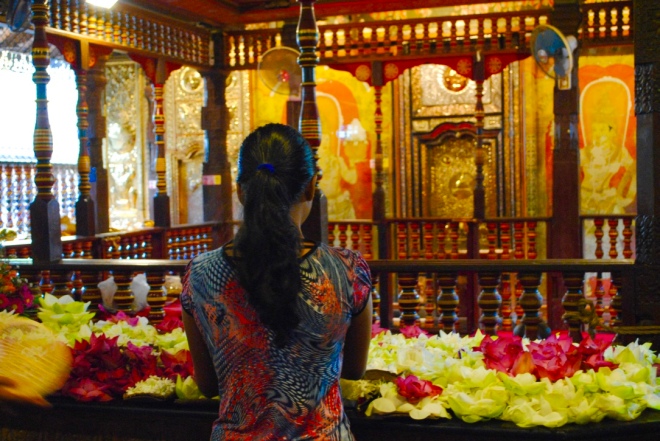


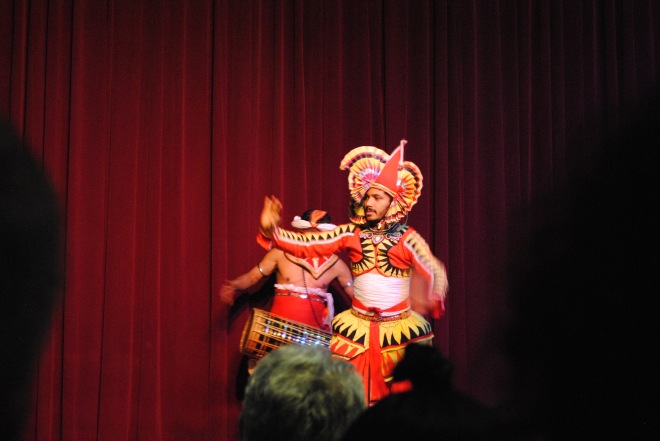
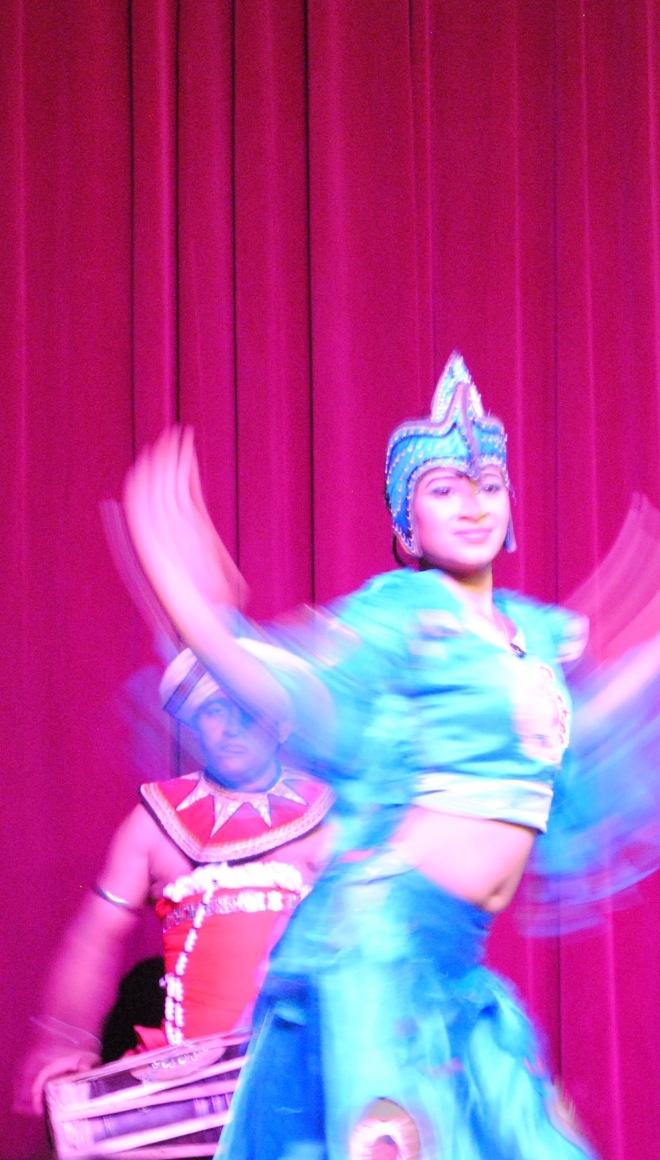
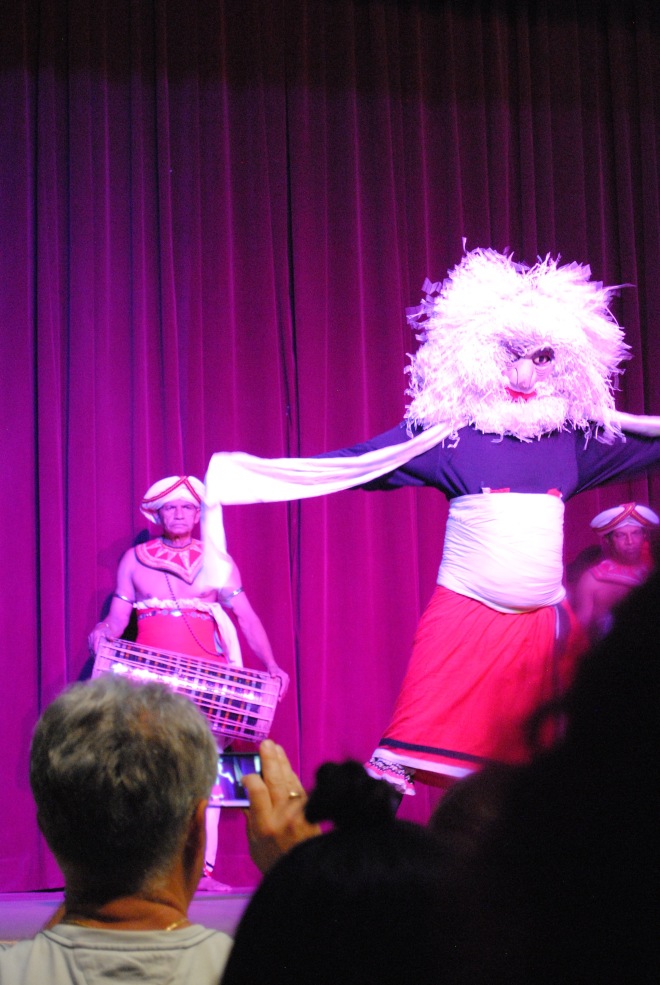
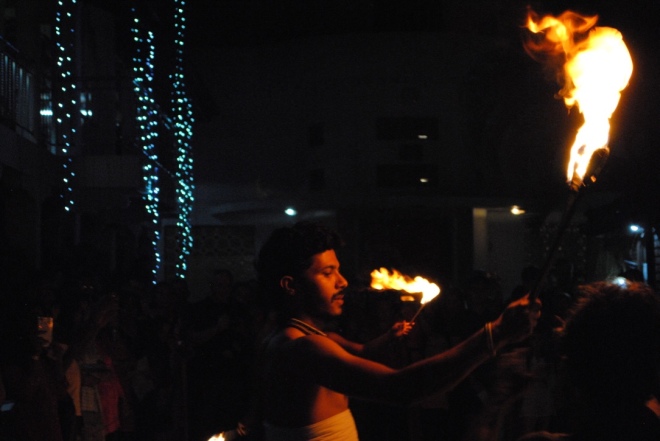 Traditional Sri Lankan Folk Dancing and Fire Twirling
Traditional Sri Lankan Folk Dancing and Fire Twirling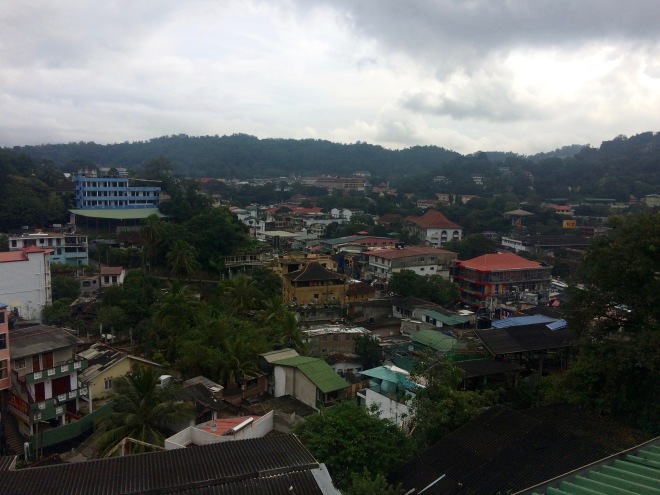 Kandy
Kandy





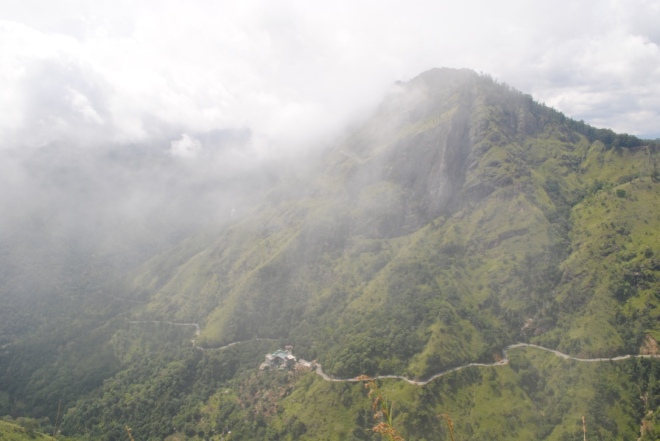





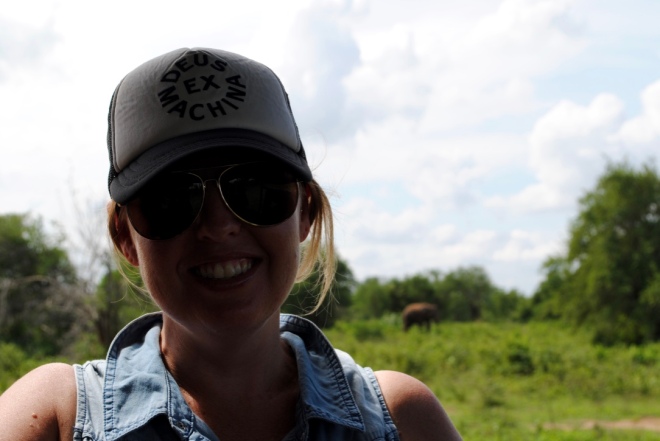

 Photograph courtesy of Samantha Jayathilaka
Photograph courtesy of Samantha Jayathilaka








































